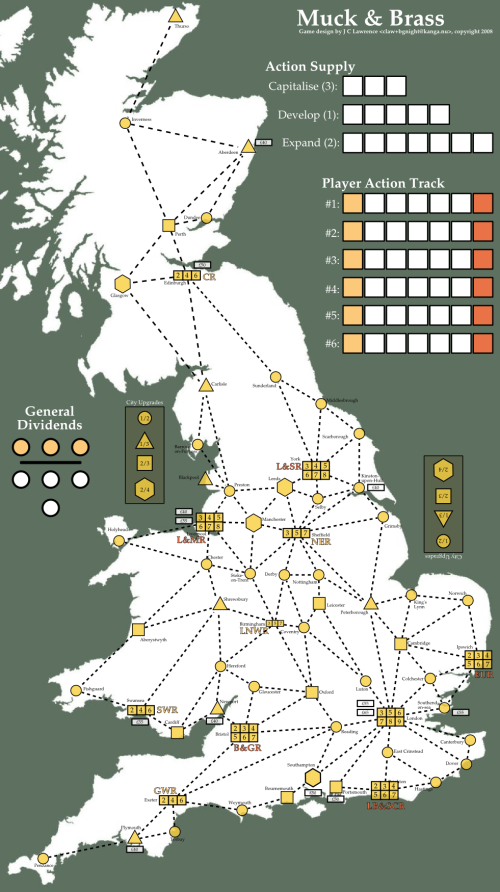Ploughing submarines
The new map fits on 18”x12” paper easily enough with broad empty swathes down the edges. It is a bit tetchy at that scale. A few of the short links such as York/Selby, Preston/Blackoool and Dover/Canterbury get to be awfully short – going smaller would present significant clarity problems. For the Europeans printing on A3 is the best bet despite being a smidge shorter than the not-quite Super-B I’m working with here. (I’d test that conjecture here if I could find a reasonable supply of A3 or Super-B paper about San Jose).

I’ve updated (increased) the port costs back to within reason. If ports are too cheap then they are used exclusively rather than mergers. As the goal of ports is to a provide way for minor shareholders to drain gobs of cash from companies and to thereby ensure that they are not able to cause mergers, the cost of ports has to be high enough to provide the needed drain and yet low enough to prevent casual use. (ie more than $30 but not too much more) Meanwhile other players push for mergers as they solidify share positions and aggregate treasuries for further dividending activities.
Unfortunately the empty spaces along the edges of the new map aren’t large enough to fit the income track or the bank pool spaces. Instead I’ve made a separate tracks page that will fit comfortably on letter or A4 for those details:

And of course some rules polishing. The changelog:
- Ports and mergers cause a (forced) capitalisation
- Forced capitalisations cost 3 days! (This is big)
- Added rules section for forced capitlisation
- Sized bank described as ~$4K
- Pumped port values most of the way back up
- Removed several ports
- Clarified glossary
- Clarified double build language
- Development rule WRT London clarified to account for Liverpool and York.
- Added scoretrack page.
The forced capitalisations for ports and mergers is a huge question. There are good reasons to think it is a great idea, as a control on late game velocity, but also good reasons to fear it slows down the effective rate of capitalisations in the late game which in turn delays the rate at which secondary companies enter the game and that is a problem. I’m finding modelling this problem fiendishly difficult; it is so sensitive to exact player positions and incentives that I’m not yet able to predict broad pattern behaviours.
In partial response I’m considering changing the round-end determinant yet again. Currently it is two exhausted actions or two players at or past 6 days. While that’s a nice pattern it is also a wee bit slow. The new thought toy is to end the round on two exhausted actions or when all players have used at least 5 days. In a 6 player game that ensures that all rounds will end on two exhausted actions. With lower player counts it will often be all players at 5 days. Hmmmm.
New rules.